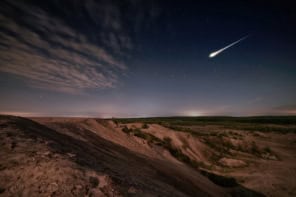
Astronomers have shown that an “inside out” planetary nebula could have been created by a “born again” event in a star that was once similar to the Sun. The observation suggests that the Sun could also experience the same fate sometime in the distant future.
Low- to medium-mass stars can be born again during the final stages of their lifetimes. This occurs when ionized gas ejected from a star is attracted back onto its surface, creating a shock that briefly re-ignites thermonuclear fusion. As this process is so brief, however, few examples have been detected, so it is poorly understood.
When stars have exhausted their fuel, several things can happen. Those heavier than about 1.4 solar masses – the Chandrasekhar limit – will explode in a supernova. However, stars of less mass that can no longer produce radiation pressure to resist the force of gravity eschew such drama and simply collapse to form white dwarves. Before they do this, however, they shed their outer layers as ionized gas creating planetary nebulae.
At this juncture about 15-20% of such stars can experience “born-again” events when the ionized gas expelled by their stellar winds is attracted back onto the stars by their gravity. This creates a shock that momentarily restarts thermonuclear fusion and creates a final flash on the star’s surface, expelling a lot of dust that then causes the star to fade from view. Several born-again events have been documented before, most recently in a planetary nebula known as Sakurai’s object observed in the 1990s.
Unpredictable structure
Planetary nebulae normally have predictable structures, with highly ionized atoms closest to the central stars where the radiation is strongest. Now, astrophysicist Martín Guerrero of the Institute of Astrophysics of Andalucia in Spain and colleagues have studied HuBi 1 – a nebula about 19,000 light-years from Earth. It surrounds a rare type of star called a [WC], whose origins have previously been unclear. Guerrero found the structure of the nebula appeared to be inverted, with the most strongly ionized atoms, which have been exposed to the strongest radiation, being furthest from the star. The researchers were mystified by this nebula, which appears to be inside out.
When Guerrero and colleagues looked at images taken in the past 46 years, they found that the nebula’s luminosity had declined by a factor of 10,000. However, the temperature of the star itself had not apparently decreased. As a result, the researchers believe the starlight is gradually being absorbed by a thickening cocoon of dust grains.
When the astronomers studied the starlight’s spectrum, the noticed strong absorption from carbon and oxygen – a characteristic feature of [WC] stars. The team believe that the dust results from a born-again event that ejects carbon-rich material explosively from the stellar surface faster than the general nebular expansion speed. As this material gets further from the star, it cools and coalesces into dust. This therefore shields the nebula from ionizing radiation, and shields the star from view.
Mystery solved?
This model could solve a mystery surrounding the origin of [WC] stars, say the researchers. Previously, a number of carbon-rich nebulae have been detected with [WC] stars at the centre, and some theoretical models have proposed that they could have previously experienced a born-again event. There has, however, been little evidence for this, and several key differences between Sakurai’s object, for example, and HuBi 1 meant that the parallel could not be assumed. Sakurai’s object, for example, faded over weeks rather than decades.

White dwarf feels the heat – again
Now, explains Guerrero, the “inside-out” nebula of HuBi 1 provides the first direct observation of a star undergoing this transition: “We see how a normal hydrogen-rich central star of a planetary nebula is evolving into a carbon-rich star,” he explains.
Moreover, say the researchers, the star appears to have similar mass as the Sun. This suggests, says Guerrero, that, when our Sun has exhausted its hydrogen and gone through the red giant phase, it may spend 10,000 years or so as a [WC] star: “If we do the statistics, maybe we’ll find there is a 10% chance of our Sun going through this event,” he explains.
“I think it’s a very interesting finding,” says astrophysicist Albert Zijlstra of the University of Manchester, who was involved in studying Sakurai’s object. “I don’t think it’s the last word on this,” he says, “and it’s possible that the model that will eventually be adopted is not quite what they propose, but that’s the way of research.”
The study is described in Nature Astronomy.



